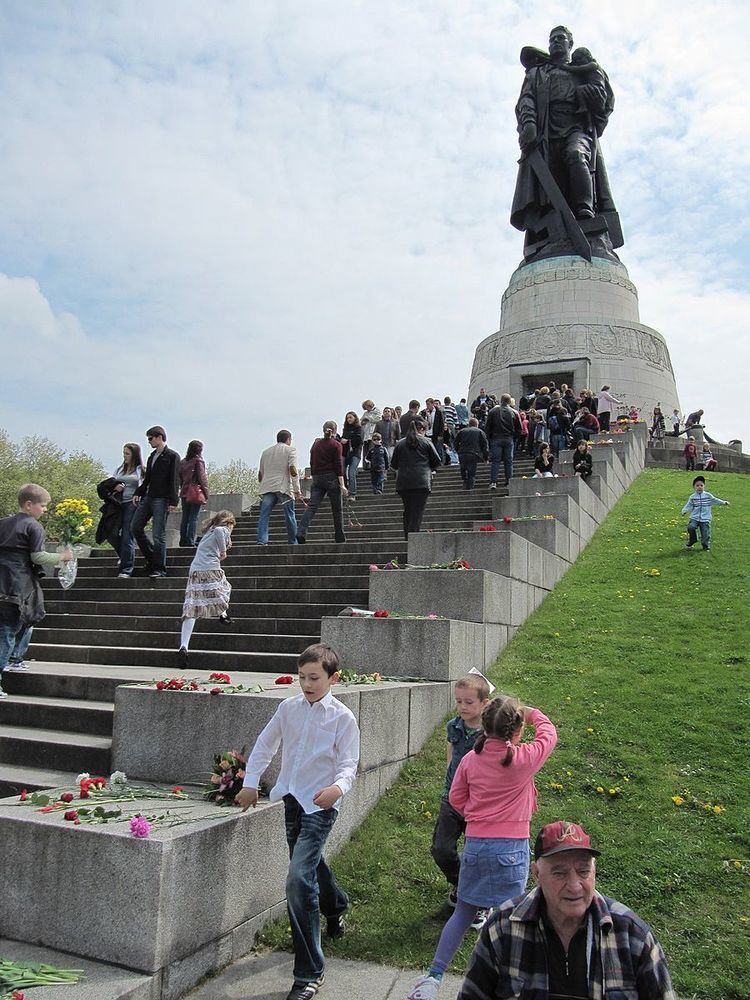Phone +49 30 25002333 | Designed by Yakov Belopolsky | |
 | ||
Established May 8, 1949 (1949-05-08) Address Puschkinallee, 12435 Berlin, Germany Hours Open today · Open 24 hoursTuesdayOpen 24 hoursWednesdayOpen 24 hoursThursdayOpen 24 hoursFridayOpen 24 hoursSaturdayOpen 24 hoursSundayOpen 24 hoursMondayOpen 24 hoursSuggest an edit Similar Treptower Park, Soviet War Memorial (Tiergarten), Reichstag building, Tiergarten, Berlin Victory Column | ||
Soviet war memorial treptower park in a berlin minute week 47
The Soviet War Memorial is a vast war memorial and military cemetery in Berlin's Treptower Park. It was built to the design of the Soviet architect Yakov Belopolsky to commemorate 5,000 of the 80,000 Soviet soldiers who fell in the Battle of Berlin in April–May 1945. It opened four years after World War II on May 8, 1949. The Memorial served as the central war memorial of East Germany.
Contents
The monument is one of three Soviet memorials built in Berlin after the end of the war. The other two memorials are the Tiergarten memorial, built in 1945 in the Tiergarten district of what later became West Berlin, and the Soviet War Memorial Schönholzer Heide in Berlin's Pankow district.
History
At the conclusion of World War II, three Soviet war memorials were built in the city of Berlin to commemorate Soviet deaths in World War II, especially the 80,000 that died during the Battle of Berlin. The memorials are not only commemorative, but also serve as cemeteries for those killed.
A competition was announced shortly after the end of the war for the design of the park. The competition attracted 33 entries, with the eventual design a hybrid of the submissions of the architect Jakow S. Belopolski, sculptor Yevgeny Vuchetich, painter Alexander A. Gorpenko and engineer Sarra S. Walerius. The sculptures, reliefs, and 2.5 meter diameter "Flammenschalen" (flame bowls) were cast at the Kunstgießerei Lauchhammer in 1948. The memorial itself was built in Treptower Park on land previously occupied by a sports field. The memorial was completed in 1949. The stones and granite that were used in the construction came from the demolished New Reich Chancellery.
Around the time of the fall of the Berlin wall, unknown persons vandalized parts of the memorial with anti-Soviet graffiti. The PDS claimed that the vandals were right-wing extremists and arranged a demonstration on January 3, 1990; 250,000 GDR citizens participated. Through the demonstrations, the newly formed party stayed true to the communist roots of its founding party, and attempted to gain political influence. PDS chairman Gregor Gysi took this opportunity to call for a Verfassungsschutz ("Constitution Protection") for the GDR, and questioned whether the Amt für Nationale Sicherheit (Department of National Security, the successor of the Stasi) should be reorganized or phased out. Historian Stefan Wolle believes that Stasi officers may have been behind the vandalism, since they feared for their jobs.
As part of the Two Plus Four Agreement, Germany agreed to assume maintenance and repair responsibility for all war memorials in the country, including the Soviet memorial in Treptower Park. However, Germany must consult the Russian Federation before undertaking any changes to the memorial.
Since 1995, an annual vigil has taken place at the memorial on May 9, organized by (among others) the Bund der Antifaschisten Treptow e.V. ("Anti-fascist Coalition of Treptow"). The motto of the event is the "Day of Freedom", corresponding to Victory Day, a Russian holiday and the final surrender of German soldiers at the end of World War II.
Layout
The focus of the ensemble is a monument by Soviet sculptor Yevgeny Vuchetich: a 12-m tall statue of a Soviet soldier with a sword holding a German child, standing over a broken swastika. According to Marshal of the Soviet Union Vasily Chuikov, the Vuchetich statue commemorates the deeds of Sergeant of Guards Nikolai Masalov, who during the final storm on the center of Berlin risked his life under heavy German machine-gun fire to rescue a three-year-old German girl whose mother had apparently disappeared.
Before the monument is a central area lined on both sides by 16 stone sarcophagi, one for each of the 16 Soviet Republics (in 1940–56 then up to the reorganization of the Karelo-Finnish SSR into the Karelian ASSR there were 16 "union republics") with relief carvings of military scenes and quotations from Joseph Stalin, on one side in Russian, on the other side the same text in German: "Now all recognize that the Soviet people with their selfless fight saved the civilization of Europe from fascist thugs. This was a great achievement of the Soviet people to the history of mankind". The area is the final resting place for some 5000 soldiers of the Red Army.
At the opposite end of the central area from the statue is a portal consisting of a pair of stylized Soviet flags built of red granite. These are flanked by two statues of kneeling soldiers.
Beyond the flag monuments is a further sculpture, along the axis formed by the soldier monument, the main area, and the flags, is another figure, of the Motherland weeping at the loss of her sons.
In recent years, the ensemble has undergone a thorough renovation. In 2003 the main statue was removed and sent to a workshop on the island of Rügen for refurbishment. It was replaced on May 4, 2004.
